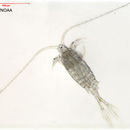fr
noms dans le fil d’Ariane


Body usually transparent, with additions of pigmentation ranging in color from yellow and orange to blue. Eye dark purple.
Very common species, occurs in all temperate and sub-Arctic waters of the Northern Hemisphere.
Euryhaline, brackish, coastal species. Occurs in shallow, warmer waters.
Heterotopic species, which spends part of its life cycle in the plankton and part on the sea floor in the form of resting eggs. In sub-Arctic and Arctic water reaches maximum abundance in the period of the highest surface water temperature and is absent from the plankton in the winter months. Can have up to 3 generations in a summer, the last of which produces resting eggs that will only develop in the following spring.
Female: Head separate from thorax. Has a bifurcate rostrum with 2 filaments. Forehead with a narrower front end and rounded tip. The abdomen is shorter than the thorax. Back corners of the last thoracic segment carry asymmetrical sharp spines. The right spine is larger and faces to the side; the left is smaller and faces toward the back. When looking from the side, the left side of the last thoracic segment carries a short stout and curved spine. The genital segment carries numerous small spines, which are distributed asymmetrically and a large spine on the ventral side, which faces toward the end of the segment. The left side of the segment contains 3 uneven rows of small spines, the right side is inflated and carries 2 larger lateral spines and above them a group of smaller spines. Caudal rami asymmetrical; the left is longer than the right and 2.5 longer than the anal segment. P5 is symmetrical and similar to previous appendages; only difference is the presence of a large protrusion on the second segment of the exopodite. This protrusion is slightly longer than the length of the segment holding it and is covered with 2 rows of serrations. A1 somewhat longer than the length of the body.
Male: The spines at the sides of the last thoracic segments are much smaller and both facing toward the back. The distal segment of the exopodite of the left P5 in narrowed and lacks armature. The exopodite of the right P5 forms a сhela-like structure. Right A1 is geniculate.
Eggs are released freely into the water. Egg count varies from 44 to 63 in the summer and from 14 to 18 in the fall. Winter eggs are morphologically different from the summer eggs – they contain numerous short protrusions, which resemble spines (summer eggs also contain some protrusions, but they are less abundant and greater in length).
Female: 1.30-2.10mm
Male: 1.20-1.60mm
Omnivorous, opportunistic species.
Is an important food source for planktivorous fish and fish larvae, including harvestable species (sardines and herring).
Centropages abdominalis is een eenoogkreeftjessoort uit de familie van de Centropagidae.[1] De wetenschappelijke naam van de soort is voor het eerst geldig gepubliceerd in 1913 door Sato.
Bronnen, noten en/of referenties